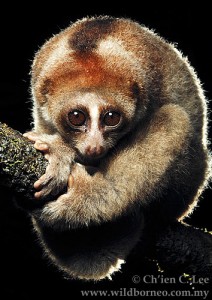
One of the newly identified species of slow loris, Nycticebus kayan. (Photo: Ch’ien C Lee)
An endangered lemur-like primate with two tongues and a toxic bite has more branches on its family tree than originally thought.
Writing in the American Journal of Primatology, Missouri researchers say they’ve identified three new species of the slow loris – the only venomous primate in the world – living on the Indonesian island of Borneo.
At first glance, with its big brown eyes and teddy-bear face, this nocturnal mammal appears cute and cuddly, but it’s got a lethal bite, which can cause fever, pain and swelling. For humans who suffer from allergic reactions, it can also be deadly.
Due to a benign appearance, and its uses in traditional medicine, the slow loris is a favorite of poachers throughout southeastern Asia and its surrounding islands.
The three newly identified species were originally grouped with another species. Now that the slow loris has been divided into four distinct classes, its risk of extinction is greater than previously believed. However, in the long run, it could also help efforts to protect the primate.
“Four separate species are harder to protect than one, since each species needs to maintain its population numbers and have sufficient forest habitat,” says lead author Rachel Munds from University of Missouri. “Unfortunately, in addition to habitat loss to deforestation, there is a booming black market demand for the animals. They are sold as pets, used as props for tourist photos or dismembered for use in traditional Asian medicines.”

The teeth of a juvenile slow loris are removed by an animal trafficker. (Photo: International Animal Rescue)
Munds says slow lorises are not and cannot be domesticated and that keeping them as pets is cruel. The primates are protected under the Convention on International Trade in Endangered Species.
“Zoos rarely succeed in breeding them,” says Munds. “Nearly all the primates in the pet trade are taken from the wild, breaking the bonds of the lorises’ complex and poorly understood social structures.”
Those who breed them as pets often pull out the teeth, depriving the the animal of its venomous bite. Many of these illegally captured primates die due to the foul conditions of pet markets.
“Once in the home, pet keepers don’t provide the primates with the social, nutritional and habitat requirements they need to live comfortably,” Munds says. “Pet keepers also want to play with the nocturnal animals during the day, disrupting their sleep patterns.”

The under-tongue of a slow loris sticks out beneath the primary tongue. (Photo: David Haring – Duke Lemur Center)
The Missouri researchers examined various museum specimens, photographs and actual live animals that had been lumped into the original single species. After noticing the animals had different body sizes, fur thickness, habitats and facial markings, scientists realized they’d identified four separate species of the slow loris rather than just the one.
Now instead of one animal listed as vulnerable by the International Union for the Conservation of Nature, there may be four endangered or threatened species.



 Science World is VOA’s on-air and online magazine covering science, health, technology and the environment.
Science World is VOA’s on-air and online magazine covering science, health, technology and the environment.